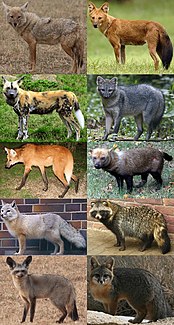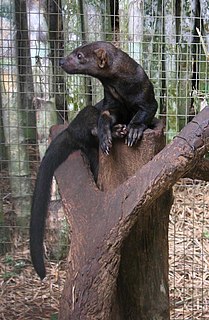
The biological family Canidae is a lineage of carnivorans that includes domestic dogs, wolves, coyotes, foxes, jackals, dingoes, and many other extant and extinct dog-like mammals. A member of this family is called a canid.

Eagle is the common name for many large birds of prey of the family Accipitridae. Eagles belong to several groups of genera, not all of which are closely related. Most of the 60 species of eagle are from Eurasia and Africa. Outside this area, just 14 species can be found—2 in North America, 9 in Central and South America, and 3 in Australia.
Binomial nomenclature, also called binominal nomenclature or binary nomenclature, is a formal system of naming species of living things by giving each a name composed of two parts, both of which use Latin grammatical forms, although they can be based on words from other languages. Such a name is called a binomial name, a binomen, binominal name or a scientific name; more informally it is also called a Latin name. The first part of the name – the generic name – identifies the genus to which the species belongs, while the second part – the specific name or specific epithet – identifies the species within the genus. For example, humans belong to the genus Homo and within this genus to the species Homo sapiens. Tyrannosaurus rex is probably the most widely known binomial. The formal introduction of this system of naming species is credited to Carl Linnaeus, effectively beginning with his work Species Plantarum in 1753. But Gaspard Bauhin, in as early as 1622, had introduced in his book Pinax theatri botanici many names of genera that were later adopted by Linnaeus.

Pangolins or scaly anteaters are mammals of the order Pholidota. The one extant family, Manidae, has three genera: Manis, which comprises four species living in Asia; Phataginus, which comprises two species living in Africa; and Smutsia, which comprises two species also living in Africa. These species range in size from 30 to 100 cm. A number of extinct pangolin species are also known.

Megabats constitute the family Pteropodidae of the order Chiroptera (bats). They are also called fruit bats, Old World fruit bats, or, especially the genera Acerodon and Pteropus, flying foxes. Megabats are found in tropical and subtropical areas of Eurasia, Africa, and Oceania. Compared to insectivorous bats, fruit bats are relatively large, and with some exceptions, do not navigate by echolocation. They are herbivores and rely on their keen senses of sight and smell to locate food.

The Parvoviridae are a family of small, rugged, genetically-compact DNA viruses, known collectively as parvoviruses. There are currently >75 species in the family, divided among 13 genera and two subfamilies. Members of this family infect a wide array of animal hosts and have been divided into two subfamilies, which infect either vertebrates or invertebrates (Densovirinae).

A spirochaete or spirochete is a member of the phylum Spirochaetes, which contains distinctive diderm (double-membrane) bacteria, most of which have long, helically coiled cells. Spirochaetes are chemoheterotrophic in nature, with lengths between 3 and 500 µm and diameters around 0.09 to at least 3 µm.

The ostriches are a family, Struthionidae, of flightless birds. The two extant species of ostrich are the common ostrich and Somali ostrich, both in the genus Struthio, which also contains several species known from Holocene fossils such as the Asian ostrich. The common ostrich is the more widespread of the two living species, and is the largest living bird species. Other ostriches are also among the largest bird species ever.

Woodpeckers are part of the family Picidae, a group of near-passerine birds that also consist of piculets, wrynecks, and sapsuckers. Members of this family are found worldwide, except for Australia, New Guinea, New Zealand, Madagascar, and the extreme polar regions. Most species live in forests or woodland habitats, although a few species are known that live in treeless areas, such as rocky hillsides and deserts, and the Gila woodpecker specialises in exploiting cacti.

Bandicoots are a group of about 20 species of small to large-sized, terrestrial marsupial omnivore in the order Peramelemorphia. They are endemic to the Australia–New Guinea region.

The tanagers comprise the bird family Thraupidae, in the order Passeriformes. The family has an American distribution. The Thraupidae are the second-largest family of birds and represent about 4% of all avian species and 12% of the Neotropical birds.

In biology, a monotypic taxon is a taxonomic group (taxon) that contains only one immediately subordinate taxon.

The Rhizobiales are an order of Gram-negative Alphaproteobacteria.

Macrochelys is a genus of very large freshwater turtles in the family Chelydridae from Southeastern United States. Only a single extant species was recognized until a 2014 study divided it into several species.

Ferret-badgers are the five species of the genus Melogale, which is the only genus of the monotypic mustelid subfamily Helictidinae.

Guloninae is a subfamily of the mammal family Mustelidae distributed across Eurasia and the Americas. It includes martens and the fisher, tayra and wolverine. These genera were formerly included within a paraphyletic definition of the mustelid subfamily Mustelinae.

Neotragus is a genus of dwarf antelope, native to Africa. The genus includes only a single species without any dispute, namely Neotragus pygmaeus. Recent nucleic acid studies now suggest that the other two species formerly included in the genus are not closely related, and should be assigned to the genus Nesotragus.
The Platyproteum are a genus of parasitic alveolates in the phylum Apicomplexa. Species in this genus infect marine invertebrates.
Filipodium is a genus of parasites in the phylum Apicomplexa. Species in this genus infect marine invertebrates.

Ictonychinae is a subfamily of the mammal family Mustelidae found mainly in the Neotropics and Africa, with one Eurasian member. It includes the grisons, Patagonian weasel, striped polecats, African striped weasel and marbled polecat, respectively. These genera were formerly included within a paraphyletic definition of the mustelid subfamily Mustelinae.

















